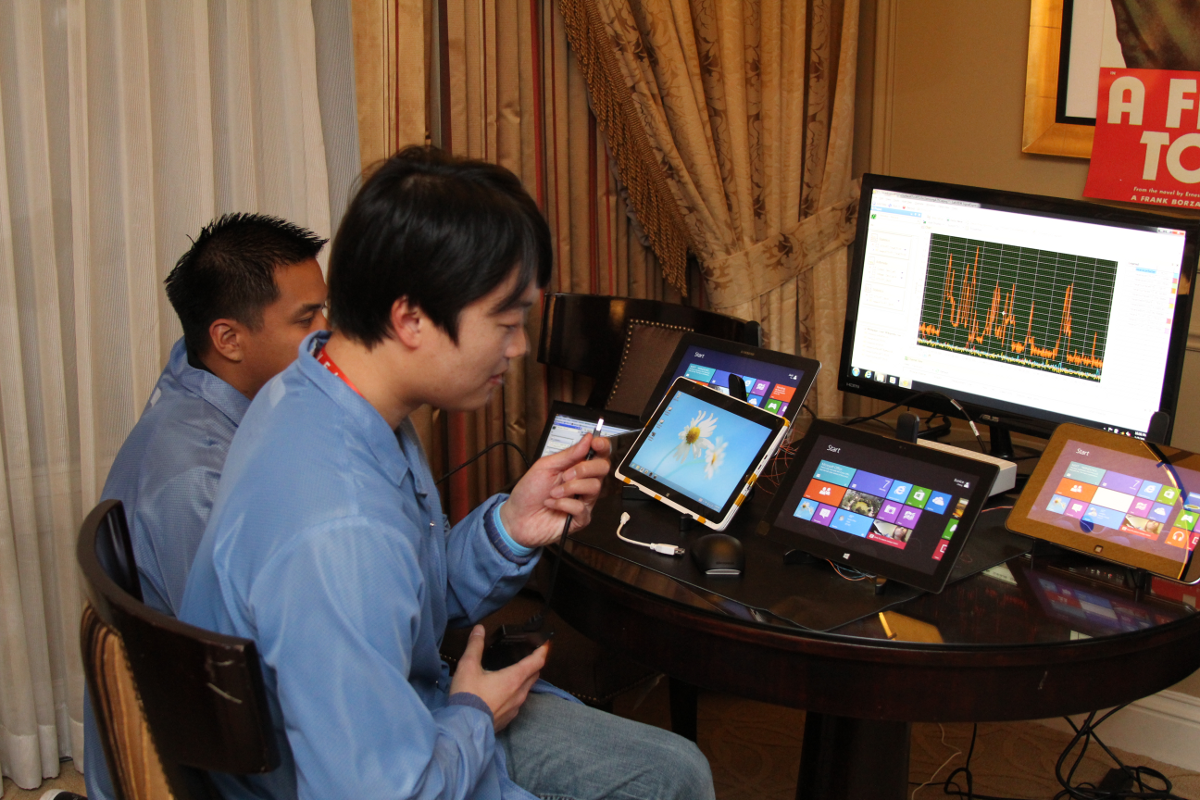Update: Intel Expands Our Battery Testing At CES 2013
We've already shown that x86 competes readily with ARM's simpler architecture when it comes to battery life. We continue our investigation at this year's CES, where Intel came packing its own tests on four current-generation tablets.
Why You Need To Look At Tablet Power Benchmarks Critically
At this year's CES, we had a chance to spend several hours with Intel engineers in the company's suite at the Venetian, breaking down the power consumption of four new tablets based on Intel's own Atom Z2760, Nvidia's Tegra 3, and Qualcomm's APQ8060.
Benchmarking is tricky business. When testing graphics cards, we’re accustomed to presenting performance as an average frame rate over time. But we know that isn’t an absolute representation. When we evaluate storage, we run corner cases and real-world transfer tests. But, again, we know those metrics don’t necessarily characterize every aspect of how drives behave, particularly since drive behavior changes over time. Similarly, when measuring how much power a tablet consumes and how long its battery lasts under a given workload, keep one thing in mind: that measurement is really only good for one specific test, and therefore not necessarily reflective of what you plan to do with the device. The graphics and storage considerations are nothing new, but when it comes to power testing tablets, how much can the benchmark workload really affect the outcome?
Plenty, it turns out. Enough to change the finishing order in our battery testing.
Testing Power Granularly, Again
Why go to all of this trouble in the first place? Well, Intel is naturally concerned about the perception that its x86 ISA is more complex, and therefore less viable in the mobile space. The company is eager to dig in as deep as possible to as many devices as possible based on its own technology and the competition. Alan’s piece, ARM Vs. x86: The Secret Behind Intel Atom's Efficiency, covered much of that though, illustrating the power performance of both Atom and Tegra 3 using defined benchmarks.
We’re interested because the hardware has been, up until now, so black-box. You have a smartphone or a tablet, you run what limited tests there are available for a given mobile operating environment, and you try to draw comparisons to dissimilar architectures.
But what if the Web browsing and video playback battery life tests you’ve seen up until now weren’t telling you as much as they possibly could? What if connecting leads to the battery, processing cores, graphics engine, and panel shed even more light onto how the tablet you have your eye on might behave under the tasks you typically perform?
Get Tom's Hardware's best news and in-depth reviews, straight to your inbox.
After running three Web-based workloads and a pair of video playback tests, it quickly became clear that drawing sweeping conclusions about power is uninformed at best, and misleading at worst.
Current page: Why You Need To Look At Tablet Power Benchmarks Critically
Next Page Test Setup And System Specs-
archange Are there any news about the 5th companion core in Tegra being supported under RT? Is software patching feasible?Reply -
abbadon_34 Please tell me the "Metro" reference in IE10 does not mean some forced Win8/Metro style interface. They've lost enough users to other browsers, do they want the rest to jump ship?Reply -
tomfreak whatever it is, 5-10hours of battery life is not good enough. 24hours is the ideal length.Reply -
archange abbadon_34Please tell me the "Metro" reference in IE10 does not mean some forced Win8/Metro style interface. They've lost enough users to other browsers, do they want the rest to jump ship?Reply
It's not "forced". On w8 you get applications specifically designed for touch input. Basically, you have two versions of IE10: the "regular" desktop one and the "Metro" version. The latter has re-placed the URL / search bar at the bottom and has larger, finger-friendly buttons. It also hides its bars for a full-screen browsing experience, which comes in handy on smaller tablet screens. Oh, and I don't use it. Dunno why, but it just doesn't appeal to me :P -
vaughn2k AMD should never had sold the (Imageon) Adreno to Qualcomm.. they should have been gaining business in the mobile business by now... Ruiz was a @*!!@$$...Reply -
ojas Also an interesting read:Reply
Anand's pre-CES article b/w Atom, Krait and the Cortex A15:
http://www.anandtech.com/show/6536/arm-vs-x86-the-real-showdown -
ojas Was interested to read about the predictions for this year.Reply
In order to get the 5-10 hours of gameplay, Tegra 4 would need to run between 3.8 and 7.6 W. We're immensely curious to see if the company can do this.
Anand estimated a 8w TDP for a quad core A15, i think it was the Exynos....with that in mind...i think you're indeed right about your estimate...
The yellow line is the time he's gaming.
Intel claims that its Haswell architecture will be exerting influence in the same space as quad-core Cortex-A15-based devices by the end of the year.
True...Ivy Bridge's already dipped to 7w... -
kyuuketsuki So... you list those 3 SoCs as defining the 2013 tablet space and completely ignore:Reply
1) Samsung's A15-based Exynos
2) AMD's Temash
The heck? -
cangelini KyuuketsukiSo... you list those 3 SoCs as defining the 2013 tablet space and completely ignore:1) Samsung's A15-based Exynos2) AMD's TemashThe heck?We didn't have that hardware on-hand in Vegas, but certainly would like to add those numbers!Reply


